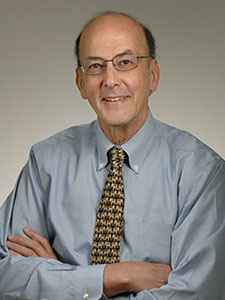To improve global health, we need to invest in people
May / June 2022 | Volume 21 Number 3
The World Health Organization estimates an
additional 18 million health workers are needed to achieve functional health systems across the globe by 2030. Currently, programs such as the U.S. President’s Emergency Plan for AIDS Relief and the U.S. President’s Malaria Initiative contribute $1.56 billion annually to support the global health workforce. Now, President Biden is calling on Congress to approve an additional $1 billion to fund the
Global Health Worker Initiative. This program would serve as a framework to guide investments while strengthening coordination among our partners, including other nations, regional organizations, and the private sector.
 Read recent
opinion pieces from Fogarty Director Dr. Roger I. Glass.
Read recent
opinion pieces from Fogarty Director Dr. Roger I. Glass.
The initiative rests on four pillars: protection of health workers; expansion of the workforce; advancement of equity and inclusion; and promotion of technological solutions. These pillars have long been familiar to Fogarty. Our unique mission includes fostering the workforce of early-stage researchers and building research capacity in low- and middle-income countries (LMICs). Since 1989, more than 7,500 individuals from over 130 countries have been trained through our many programs including our AIDS International Research Training Program and Medical Education Partnership Initiative
New technologies play an important role in addressing workforce issues and the future of health care itself. Recently, one of our medical school fellows working in Uganda encountered a child with a disfigured face. The student sent a photo of the child to a dermatologist friend, who recognized the symptoms and prescribed an antifungal medication. The child, stigmatized for years, took the medication and experienced a rapid recovery. The lesson here is not that the medical student was brilliant… he was simply connected.
One of our most novel programs with the greatest numbers of grant submissions is
Fogarty’s Mobile Health (mHealth) initiative. In Africa, it has been said that more people have cell phones than toilets. Mobile health solutions can fill gaps by empowering community health workers to perform medical tasks, connect patients with resources, or arrange access to clinics or medical facilities. Fogarty mHealth projects have included cell phone-based solutions that link high-risk pregnant women to birthing centers; screen people with poor vision; monitor patients to ensure adherence to their medications, (e.g., drugs for tuberculosis, HIV, and high blood pressure); identify new cases of leishmaniasis; diagnose cervical cancer; and
connect oncology professionals to patients in need of palliative care. Telemedicine, which exploded in the U.S. during the pandemic, can similarly help people in low resource settings who seek medical advice for non-urgent health issues. Technology—both the digital tools carried in health workers’ hands and the enterprise level systems supporting these tools—can train professionals, extend a worker’s reach, and drive innovation. Technology—both the digital tools carried in health workers’ hands and the enterprise level systems supporting these tools—can train professionals, extend a worker’s reach and drive innovation.
I must add that Fogarty focuses on developing a research workforce because the delivery of health care is ever-changing and driven by data science and innovation. It is researchers who create new ways to deliver care, monitor adherence to treatment, and document recovery or failure. Fogarty seeks research leaders who can anticipate what’s ahead and understand how to become the agents of change we need.
Fogarty also prizes equity and inclusion because we understand that patients respond best to health workers who look like themselves, whether ethnic minorities, women, the disabled, or rural inhabitants. Given that women represent 70% of the health care workforce worldwide, we need to address issues of unpaid labor, unequal salaries, and lack of maternity leave, and how these impact quality of care. We also need to ensure girls can complete their education since many drop out when they start their period because their schools don’t have appropriate sanitation facilities.
When I first worked in Bangladesh more than three decades ago, our field teams were composed exclusively of men, while women were hired as part-time contractors so they could not rise into positions of leadership. The men felt that hiring a woman would “be taking a job from a man.” Today, I can happily report that these old traditions have changed. Women have entered the workforce, and this has led to an upgrade of status and paying jobs.
The spectrum of health worker occupations is vast and includes not only community health workers, nurses, and physicians, but researchers, laboratory scientists, pharmacists, public health workers, supply chain experts, and future leaders. Spending on these skilled workers provides, on average, a nine-to-one return on investment, said economic advisor Daleep Singh at the May launch of the Global Health Worker Initiative. I, too, believe that when we invest in worthy people and encourage them in research, we never go wrong.
More information
Updated June 15, 2022
To view Adobe PDF files,
download current, free accessible plug-ins from Adobe's website.
Related Fogarty Programs